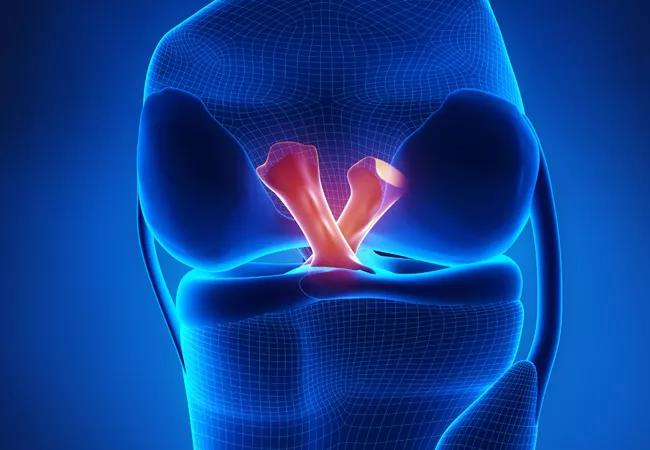Bone-shape changes play a role in the development of arthritis, a new study suggests

Early bone-shape changes may predict the development and extent of post-traumatic osteoarthritis (PTOA), according to a new study published in Osteoarthritis and Cartilage. Bone-shape changes following ACL repair (ACLR), as measured by comprehensive 3-D imaging, may allow for interventions to reduce the severity of any future disease.
Advertisement
Cleveland Clinic is a non-profit academic medical center. Advertising on our site helps support our mission. We do not endorse non-Cleveland Clinic products or services. Policy
“Osteoarthritis is a complicated disease,” says Xiaojuan Li, PhD, Director of the Cleveland Clinic Program for Advanced Musculoskeletal Imaging (PAMI), and the inaugural Bonutti Family Endowed Chair for Musculoskeletal Research. “Radiographs are not sensitive enough to detect subtle changes to joint structure that might be harbingers of arthritis. Our long-term goal with this research is to find a way for imaging to be used as a biomarker for people at high risk for developing osteoarthritis.”
In this recent study, Li and her colleagues used computational analysis of 3-D MRI, statistical shape modeling and patient reported symptoms, to assess risk factors for the development of PTOA following ACLR. They sought to identify possible correlations between bone-shape changes and cartilage health over time.
They found that bone-shape changes, such as femur sphericity, notch width, tibial area and tibial slope, in the three years immediately following ACLR may be biomarkers for future PTOA.

The physical interpretation of bone shape modes. Left: representative shapes from control knees; right: representative shapes from ACL injured knees. (A) Femur Mode 2: medial femoral condyle shape; (B) Femur Mode 6: notch width; (C) Tibia Mode 1: tibia plateau area; (D) Tibia Mode 7: medial tibia slope; (E) Femur Mode 8: trochlea inclination and medial femoral condyle height. A: anterior; P: posterior; S: superior; I: inferior; M: medial; L: lateral. Note: these shape features are the major ones associated with these modes. Each mode represents a whole set of 3-D bone shape features beyond a single shape feature.
Advertisement
“The statistical methods used in identifying bone-shape changes via 3-D MRI quantify bone-shape changes comprehensively without prior assumptions. They allow researchers to simply look at what the data shows to generate hypotheses without bias,” Dr. Li states.
“For example, there are differences in the intercondylar notch width and tibial slope between people with ACL tears and healthy controls. With this method we can scientifically confirm the variance using these images and analyses, and then measure how the differences progress over time.”
Six months might not seem like enough time to see significant changes in bone shape; however, this research confirmed statistically significant changes in that short period. For example, the tibial plateau area, which at baseline was similar between both cohorts, become larger after injury. In patients with ACL tears, changes to the tibial area within the first six months following ACLR were mostly related to cartilage changes.
“The ability to accurately predict which patients are at high risk for PTOA may provide the opportunity for preventive interventions, because by the time patients develop symptoms of osteoarthritis, it may be too late,” says Dr. Li. “This modeling can identify patients who may benefit from early pharmaceutical intervention, possibly slowing down the disease course or reducing symptom severity.”
“Next steps in this research involve building scale. We are working with the Arthritis Foundation to establish a nationwide infrastructure of charter sites with the capability of recruiting patients for pharmaceutical trials, as they become available, and from whom we can obtain imaging and biomarkers to give us data from a larger cohort.”
Advertisement
Xiaojuan Li, PhD, serves as Director of the Program for Advanced Musculoskeletal Imaging (PAMI) and holds the Bonutti Family Endowed Chair for Musculoskeletal Research. Established in August 2017 as a multidisciplinary program between Cleveland Clinic’s Lerner Research Institute, Orthopaedic and Rheumatology Institute, and Imaging Institute, PAMI’s goal is to bring people together to perform imaging-related research and rapidly translate the developed techniques to clinical practice.
Note: Image used with permission from Osteoarthritis Cartilage.
Advertisement
Advertisement

First full characterization of kidney microbiome unlocks potential to prevent kidney stones

Researchers identify potential path to retaining chemo sensitivity

Large-scale joint study links elevated TMAO blood levels and chronic kidney disease risk over time

Investigators are developing a deep learning model to predict health outcomes in ICUs.

Preclinical work promises large-scale data with minimal bias to inform development of clinical tests

Cleveland Clinic researchers pursue answers on basic science and clinical fronts

Study suggests sex-specific pathways show potential for sex-specific therapeutic approaches

Cleveland Clinic launches Quantum Innovation Catalyzer Program to help start-up companies access advanced research technology